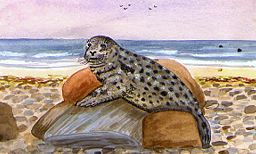Breeding
 Grey seals breed from September to December around British shores. The female gives birth to a single pup on a shore (known as a rookery) crowded with hundreds of other seals. At birth the baby is covered with a thick, creamy-white coat, but this is replaced by a greyish juvenile coat after about three weeks.
Grey seals breed from September to December around British shores. The female gives birth to a single pup on a shore (known as a rookery) crowded with hundreds of other seals. At birth the baby is covered with a thick, creamy-white coat, but this is replaced by a greyish juvenile coat after about three weeks.
The pup grows quickly on its mother's rich milk, and she abandons her offspring after three weeks, ready to mate again. The bulls (males) haul themselves onto the shore and fight each other to establish territories. The more mature, experienced bull usually wins any fight and he mates with all the females on his part of the beach.
After mating, the female returns to the sea, but the fertilised egg does not start developing until much later so the birth will be at the same time the following year.
The pups left on the beach, driven by hunger, soon take to the sea to find their first solid food. If they survive into adulthood, the males will be ready to breed at about eight years of age and the females at about five years.
Read More: Grey Seals and humans